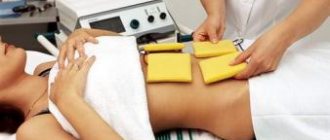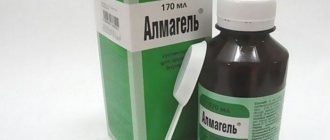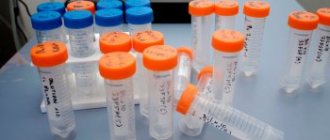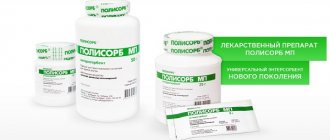Is it possible to plan a pregnancy if electrophoresis is prescribed?
During pregnancy, there are some restrictions on drug treatment. Conventional drugs have a harmful effect on the fetus, affecting the kidneys, gastrointestinal tract and liver of the expectant mother. This cannot be said about physiotherapy, the procedures of which are the safest for the treatment and prevention of various diseases. Physiotherapy involves minimal stress on the body. This treatment method is based on deep penetration of the medication through the skin or mucous membranes under the influence of electric current.
The advantage of this type of therapy is that even when low doses of the drug are administered, it is concentrated locally, gradually accumulating in the affected area, thereby achieving a positive effect.
This procedure, as already mentioned, does not have a negative effect on the body of the mother and fetus. However, one must also take into account the fact for which it was appointed. For example, if a woman is undergoing rehabilitation after a frozen or ectopic pregnancy, then there is no need to rush into the next one.
Why is electrophoresis prescribed during pregnancy: indications and contraindications
The procedure reduces the tone of the uterus that occurs after 8 weeks. First of all, magnesium preparations are administered, which we will talk about later. This measure allows you to reduce the uterine sensitivity to oxytocin, the hormone that causes its contractions. Electrophoresis is also used when there is a threat of premature birth with increased tone.
The event is indicated for cysts, adenoids, toxicosis in the early stages. Anesthetics, vitamins, enzymes, sedatives and vasodilators are used as medications.
This method is used for diseases of the nervous, respiratory and cardiovascular systems, atherosclerosis, hypotension, hypertension, inflammation, injuries, scars (after surgery), rosacea, seborrhea, pathologies of joints and bones, diseases of the eyes, ENT organs, and chronic sluggish inflammation of the female genital area and urinary system. The procedure is prescribed for neuritis, chronic bronchitis, radiculitis, neuralgia, spinal cord and brain injuries, and sleep disorders.
Contraindications to electrophoresis:
- Vomit;
- Kidney diseases;
- Eclampsia;
- Low blood clotting;
- Poor fetal development indicators.
If there are contraindications, galvanophoresis is used - a procedure during which lower currents are used. Galvanophoresis has no contraindications.
Carrying out the electrophoresis procedure
During the event, a device with two electrodes (positive and negative) is used. There are several types of electric current, in addition, the drug can also be applied in different ways.
Galfanophoresis involves wetting special pads in a medicinal solution. The solution is applied to one gasket, a second (protective) gasket is placed on top, and an electrode is placed on top. The second electrode is placed on the opposite side of the body.
The procedure can be carried out using the bath technique, which consists of using a special bath with electrodes built into it. Solutions of medications are poured into the container and the patient lowers the desired part of the body into it.
There is also a cavity technique, when medicinal solutions are injected into hollow organs, for example, the rectum, bladder, stomach, vagina, etc. Then one of the electrodes is inserted into the cavity of the diseased organ, and the second is placed on the surface of the body at the location of the pathology.
The duration of one session varies from 10 to 15 minutes. A course of physiotherapy, as a rule, ranges from 10 to 20 procedures, which are done daily or at intervals, for example, every other day.
Magnesium electrophoresis: use during pregnancy
Magnesium sulfate (magnesia) prevents miscarriage and complications:
- Relaxes the walls of blood vessels;
- Normalizes blood pressure;
- Relieves hypertension;
- Relaxes muscles;
- Has a sedative effect;
- Relieves cramps;
- Improves well-being;
- Relieves swelling, accelerates the removal of excess fluid from the body.
Procedures with magnesia can be prescribed if there is a threat of premature birth, gestosis, complications of convulsive conditions, magnesium deficiency, severe forms of hypertension, epilepsy, eclampsia in pregnant women, encephalopathy, stagnation of urine, poisoning with heavy metals (mercury, arsenic, lead).
Side effects: headache, sweating, drowsiness, anxiety, vomiting, drop in blood pressure, weakness, speech disorders. Magnesia is contraindicated at low blood pressure, when taken simultaneously with biological food additives and calcium. In large doses it acts like a narcotic. Magnesia is canceled in the prenatal state, as it prevents the dilation of the cervix.
Electrophoresis with vitamin B1: when is it necessary during pregnancy?
This procedure is widely used in gynecological practice to treat pathologies of the female reproductive system. The introduction of the vitamin through electrophoresis allows it to penetrate deep into the tissues that suffer from blood microcirculation disorders.
Vitamin B1, getting into tissues, has pronounced clinical effects, improves the patient’s condition, and accelerates the treatment of diseases.
During pregnancy, treatment with vitamin B1 through currents is used for miscarriages and early miscarriages. Physiotherapy is often combined with progesterone medications. As a result, the tone of the smooth muscles of the uterus decreases, which prevents miscarriage.
As a preventive measure and for treatment, electrophoresis is carried out with vitamin B1 6% for 10-14 days.
Electrophoresis: past endometriosis and pregnancy
Inflammation of the uterine mucosa (endometrium) often leads to organ failure. After fertilization, the egg cannot attach to the endometrium, which leads to the fading of pregnancy in the early stages, because there is no adequate blood supply and nutrition to the embryo. As a result, the pregnancy stalls or a miscarriage occurs. After this, curettage of the uterine cavity is required, which is also an additional injury to the uterine mucosa.
When endometriosis is cured, rehabilitation is required with the help of physical therapy, antibiotics and hormones (as indicated). This set of measures will restore the structure and function of the endometrium, which will have a beneficial effect on subsequent pregnancies. At the same time, it is worth noting that electrophoresis is contraindicated until endometriosis is cured (thermal procedures aggravate the course of the disease).
The procedure can also be used after childbirth to prevent endometritis.
Physiotherapeutic treatment during pregnancy must meet two main conditions: to help the expectant mother and not harm her baby. As a rule, acupuncture, electrophoresis and electrorelaxation can be used while expecting a baby.
https://youtu.be/l7S9kYBao6o
Gentle method of treatment: electrophoresis during pregnancy
Pregnancy changes a woman's life dramatically.
If previously you might not have thought much about the threats of drug treatment, then during pregnancy the safety of the child comes to the fore. But anyone can get sick, and they still need to be treated. Electrophoresis will help solve some health problems during pregnancy. It is also often used for preventive purposes as a supportive agent to improve blood circulation and reduce uterine tone. This physiotherapeutic procedure is the safest for expectant mothers, since medications reach the site of inflammation, bypassing the internal organs. This means that they will not harm either the woman or the child.
Electrophoresis can be done at any time, if there are no contraindications for this procedure.
When taking pills or potions, the medicine must first get into the stomach and then into the bloodstream. This increases the load on the liver and kidneys, since these organs are responsible for removing fluids from the body. It is also possible for drugs to penetrate the placenta, and there is a risk of disrupting the formation or development of the fetus.
The expectant mother already has a hard time - her internal organs work for two. Any use of medications during this period is undesirable. In order to avoid increasing the load on the pregnant woman’s body, but at the same time alleviate her condition, electrophoresis is performed.
The procedure allows you to avoid drugs getting into the gastrointestinal tract and bloodstream. The essence of the method is the penetration of drugs through the surface of the skin using electricity. Positively and negatively charged particles of the medicinal solution penetrate inside through the skin and intercellular space. In this case, the amount of medicine entering the body is no more than 10% of the total volume.
Note: how nephropathy manifests itself in pregnant women.
It is important to know when pregnant women need to see an osteopath.
The main dose of the drug enters the blood very slowly. It accumulates in the skin and subcutaneous layer, from where it gradually passes into the bloodstream. Thus, a long-term (day or longer) effect on a pregnant woman is achieved without increasing either the dose or the risk to the health of the mother and child.
Another advantage of electrophoresis is that the patch with the solution is located at the site of pain, that is, the action occurs only in a limited area. This allows you to increase the amount of medicine several times without fear of causing a negative reaction.
Important! Only a gynecologist observing pregnancy can prescribe electrophoresis. He makes a referral to a physiotherapist, who, in turn, conducts an examination and approves or prohibits the procedure.
Electrophoresis is the most gentle way of administering medications during pregnancy, but it can only be done if there are no restrictions, which include:
- toxicosis with constant uncontrollable vomiting;
- kidney disease;
- danger of blood loss due to poor blood clotting;
- eclampsia;
- dangerous condition of the child.
Limitations also include certain mental illnesses, the presence of a pacemaker or a malignant tumor, internal or external inflammation. Basically, the procedure does not cause side effects in most pregnant women. The current strength is set individually, but it is always small values that are not dangerous for the woman and the fetus.
Moreover, such physiotherapy improves blood circulation in all organs, including the pelvis, removing possible blood stagnation and creating an excellent environment in the uterus for embryo implantation. Therefore, there are frequent cases of pregnancy after electrophoresis, even in those who could not conceive before.
Important! Any changes in the skin, abrasions or scratches at the site of electrophoresis are contraindications.
Physiotherapy is one of the safest ways to maintain a pregnancy. If there is a threat of miscarriage after the eighth week of pregnancy, electrophoresis with a magnesium preparation (magnesia) is prescribed.
It not only relaxes the uterus, which in itself reduces the threat of miscarriage, but also reduces sensitivity to oxytocin, a substance that increases the tone of the uterus.
The same procedure also helps in later stages, when there is a risk of premature birth.
Important! Magnesia can also be administered by injection, but this is quite painful for a pregnant woman.
Physiotherapy is carried out when cysts, endometriosis, and adenoids are detected, but perhaps the biggest problem that many women face is toxicosis. In early pregnancy, electrophoresis can help cope with mild nausea and vomiting. After the procedures, the woman’s general condition improves and her appetite increases.
Important! In severe cases with constant vomiting, electrophoresis will not help. On the contrary, it can make the situation worse. Severe toxicosis and gestosis need to be treated using other methods.
To treat early toxicosis of pregnant women in a mild stage, electrophoresis with vitamin B1 or other vitamins of this group is done. The procedure is carried out through the nose, the duration of the course is determined by the doctor (usually 5-10 days).
The medicine (solution, gel) must be located between the skin and the current source (electrode). There are several ways to perform electrophoresis:
- galvanic (a napkin with a solution is applied to the surface of the skin);
- bath (the limb is immersed in a special bath);
- cavitary (the drug is administered into natural cavities);
- interstitial (injection or oral administration of medication).
Important! A slight tingling sensation at the site of application of the current is acceptable, but if the sensation intensifies, a burning sensation or pain occurs, you should immediately contact the staff and stop the procedure.
If electrophoresis of a limb is needed, the arm or leg is immersed in a special bath filled with a medicinal solution, inside which electrodes are built. The current passes through the liquid, taking with it particles of the drug, and transfers them deep into the skin.
With the cavity electrophoresis method, the solution enters the natural cavities of the body (stomach, rectum, uterus). Then one electrode is placed here, and the second is placed on the surface in the appropriate place.
- It is useful to find out whether you can whiten your teeth during pregnancy.
- Note: what are the reasons for frequent belching in pregnant women?
- It is interesting to read whether Oscillococcinum can be taken by pregnant women.
The interstitial method differs from the cavity method in the method of drug administration and the location of current sources. For example, medicine can only be administered into the bronchi or lungs by injection, and both current sources must be located outside on opposite sides.
The undoubted advantage of electrophoresis is safety for the fetus. Medicines enter the mother’s body gradually and only in a specific, sore spot; the internal organs do not suffer from increased stress.
Most often, side effects do not occur as a consequence of the procedure, but as a result of a reaction to medications. That is, only an allergy to the active components of the drug is possible, but not irritation from electric current.
Physiotherapy for threatened preterm birth
If there is a threat of premature birth, acupuncture and electrorelaxation can be used. To treat pregnant women with such a threat, it is necessary to make wider use of non-drug and physiotherapeutic means of influencing the muscles of the uterus.
Acupuncture is performed by a specialist who has studied acupuncture techniques. This method of therapy can be prescribed either alone or in combination with medications.
Electrorelaxation of the uterus is a procedure during which the neuromuscular system of the uterus is exposed to alternating sinusoidal current. This procedure suppresses the contractile activity of the uterus and reduces the likelihood of premature birth.
The advantages of the procedure are painlessness and safety for the mother and her unborn baby. To eliminate the threat of premature birth, one to three procedures are enough.
Contraindications for use
Despite the positive effects of ultraviolet irradiation, there are a number of contraindications for its use:
- In patients with cancer or suspected cancer.
- Autoimmune lupus and other diseases accompanied by increased sensitivity to ultraviolet radiation.
- At the stage of acute purulent inflammation, which occurs with high temperature, intoxication and fever.
- Tendency to develop bleeding and increased fragility of blood vessels.
- For a number of other diseases and conditions, such as tuberculosis, arterial hypertension, stomach ulcers, etc.
Important! Given the large list of contraindications, ultraviolet radiation should only be prescribed by the attending doctor after examining the patient.
During pregnancy, the appointment of physiotherapy should be agreed with the doctor. This method is allowed to be used during pregnancy for inflammatory diseases of the nasal cavity and throat after consulting a doctor.
To restore the cell, its regenerative and protective functions in case of injury or infection, it is recommended to use UV physiotherapy. But, despite the effectiveness of this treatment method, there are contraindications to its use:
- Any stage of oncology development.
- Autoimmune processes that are accompanied by sensitivity to ultraviolet radiation, for example, lupus.
- Acute purulent inflammatory processes.
- Excessive fragility of blood vessels and frequent bleeding.
- Stomach ulcer, tuberculosis and arterial hypertension.
While carrying a baby or breastfeeding, physiotherapy can only be performed with the permission of the attending physician. The appointment is performed in case of inflammation of the nasal or oral mucosa.
Spa treatment
Spa treatment helps strengthen the immune system, improve mood, calm the nervous system and prepare the body for childbirth.
If possible and there are no contraindications, all pregnant women are recommended to go to the sea. Sea bathing serves as an effective natural physiotherapy. It strengthens and tones the body of the mother and her unborn baby. Sea water contains many microelements, as well as phytoncides and proteins, which makes sea bathing extremely beneficial.
Heliotherapy is treatment with direct sunlight. This therapy enhances metabolic processes and stimulates the synthesis of vitamin D, which the unborn baby needs for the formation of bones and teeth.
For safe exposure to the sun, choose hours from 8 to 11 and after 16. Apply special protective creams for pregnant women to your skin, and cover your head with a light-colored hat.
Purpose
In what cases can a doctor prescribe physical therapy?
- During early pregnancy, sessions are prescribed in case of threat of spontaneous miscarriage. Sessions also prevent premature birth at a later date. Thus, physiotherapy during pregnancy in the 2nd trimester may be prescribed to avoid the loss of the baby.
- In the first half of pregnancy, women often suffer from toxicosis. To alleviate the condition of the pregnant woman, a course of physiotherapy is prescribed.
- Some women are overcome by gestosis, a condition similar to toxicosis, but appearing in the second half of pregnancy. Preeclampsia is a dangerous pathology of pregnancy that threatens the life of not only the baby, but also the mother. Physiotherapy helps well with gestosis.
- At the end of pregnancy, starting from the fortieth week, women are prescribed courses to prepare the body for childbirth.
- For acute inflammation of the upper respiratory tract, it is better to prescribe a course of physiotherapy instead of medications.
- In case of intrauterine growth retardation.
- With symphysiopathy - divergence of the pelvic bones. This pathology often occurs in women with many children and in multiple pregnancies.
- Physiotherapy also helps after childbirth - for the speedy healing of wounds: with perineal injuries and after cesarean section.
- In the treatment of endometritis.
- To improve intestinal motility after childbirth.
- To contract the uterus after childbirth.
When might an expectant mother need physical therapy?
Exposure to physical methods is useful for pregnant women not only during obstetric pathology, but also during periods of exacerbation of somatic diseases, as well as during colds and some infectious processes. Physiotherapy during early pregnancy will help preserve the developing fetus, and in later stages, on the contrary, prepare the body for childbirth.
Indications for sessions:
- threatened spontaneous or premature birth;
- first half of pregnancy;
- preparation for labor at 40 - 42 weeks;
- acute inflammatory diseases of the upper respiratory tract;
- gestosis during pregnancy;
- intrauterine growth retardation;
- with divergence of the pelvic bones - symphysiopathy;
- to accelerate the healing of postoperative wounds - after and perineal injuries;
- to stimulate uterine contraction during its subinvolution after childbirth;
- to enhance the repair of cracks in the nipples, as well as for the prevention and treatment of lactostasis;
- to stimulate intestinal motility during cuts, especially in the postoperative period;
- in complex treatment of inflammation of the uterine cavity.
Is physical therapy possible during pregnancy?
Pregnant women should pay great attention to the condition of their body. However, it is not always possible to protect yourself from the negative effects of the environment. The field of medicine based on treatment with natural factors such as current, water, magnets, heat and light is called physiotherapy.
Thanks to physiotherapy, a young mother can get rid of tension and spasms, swelling and pain, as well as improve blood microcirculation. The impact of natural factors is only on the source of pathology, therefore, there are no side effects from physiotherapy.
Since the use of physiotherapy excludes the use of medications, this method of preventing many diseases is the safest for a pregnant woman.
Procedures that will not cause harm
During pregnancy, each procedure must be approached with caution. After all, not every one will bring the desired effect, but it is quite capable of harming a young mother. By negligence, you can even lose your baby.
Before you start intensively using the techniques, you should consult your doctor.
.
Exposure to electric shock
As a rule, for women in an “interesting” position, direct electric current is used. Using this method of physiotherapy, it is possible to increase the flow of medicinal substances into the tissues, and the therapeutic dosage will be significantly lower than that which would be prescribed with another method of introducing the drug into the body.
Electrophoresis during early pregnancy is prescribed quite often, as well as when there is a threat of premature birth after 21 weeks of gestation. In such situations, magnesium is used as a healing solution. In minimal concentrations, magnesium ions penetrate into tissue under the influence of electric current, removing the tone of the smooth muscles of the uterus. This is an absolutely harmless procedure for the baby. Calcium electrophoresis is used to prepare a woman’s body for childbirth at the end of the third semester.
For severe toxicosis during pregnancy, endonasal electrophoresis and galvanization are used. Galvanization is a method of physiotherapy in which a low-intensity electric current is passed through special electrodes on the human body. During the procedure, the woman feels only slight warmth and tingling in the areas of application.
Electrosleep is the effect of pulsed currents on the cerebral cortex. Physiotherapy is used in complex treatment for gestosis in the third trimester, when there is an increase in pressure, swelling and changes in clinical blood and urine tests.
Barotherapy
This method involves exposing the body to increased or decreased atmospheric pressure. In obstetric practice, hypobaric oxygenation is used in situations where the baby is stunted in utero. Barotherapy helps improve blood circulation, even the development of new small vessels - capillaries, including in the placenta. A full course requires at least 10 sessions.
Massage during pregnancy
The main effect of the procedure is relaxation of muscles and ligaments. This is relevant for pregnant women, because an expanding belly puts strain on the lower back, and even minor swelling in the legs and arms can cause discomfort, paresthesia - “goosebumps”. Many women wonder if massage is possible during pregnancy. It is allowed to use both hardware and manual, but on certain parts of the body - on the legs, arms, head and back of the head. You will have to give up, especially in the second and third trimesters. Anti-cellulite products should be approached with extreme caution.
Physiotherapy for other diseases during pregnancy
In the complex treatment of rhinitis and sinusitis, ultraviolet irradiation, UHF therapy, and laser radiation are used. The latter can be used by a woman at home.
If a pregnant woman suffers from bronchial asthma or chronic bronchitis, at the time of exacerbation of the disease, phonophoresis and electrophoresis can be used on certain segments of the chest, as well as inhalation with medicinal solutions.
How does the procedure work?
No special preparation is required for the procedure, however, in case of sinusitis with heavy discharge, the doctor will rinse the nasal passages and paranasal sinuses from accumulated mucus.
In case of severe nasal congestion, any vasoconstrictor drug should be instilled first. After this, the following processes occur:
- The patient needs to take a comfortable position on a chair.
- The doctor installs the plates of the device in the area of the maxillary sinus parallel to the wings of the respiratory organ.
- First, a gel and dense fabric are applied to the patient’s skin, which prevents direct contact.
- The impact of ultra-high frequency therapy lasts about twenty minutes.
The course of treatment depends on the form and severity of the disease. Typically, at least five treatments are required for complete cure.
Types of exposure that should be approached with caution
Any procedures, even at first glance absolutely safe for mother and baby, should be carried out only after examination by a gynecologist, who will exclude harmful effects specifically for each woman in a given clinical situation. Procedures that are harmless for some may provoke undesirable consequences for others.
The use of physical therapy such as mud and hydrotherapy should also be limited, especially in the second and third trimesters. Before 12 weeks, you should approach their use after assessing all possible risks.
Are all procedures safe?
There are a huge number of types of physiotherapy today. But not all of them will benefit expectant mothers; some should be used with caution and only under the supervision of a doctor. If you want to undergo a course of physical therapy yourself, then first consult with the gynecologist leading your pregnancy.
Next, we suggest that you familiarize yourself with absolutely safe procedures and those that need to be treated with caution.
Physiotherapy prohibited during pregnancy
As already mentioned, there are techniques that are strictly prohibited for young mothers. Fortunately, there are not many of them.
Magnetic influence
This type of physiotherapy has anti-inflammatory, anti-edematous, sedative and analgesic effects. During pregnancy at any stage, the use of even local sources of alternating or constant magnetic fields, for example, on the joints of the arms and legs, is not allowed.
Microwave therapy
It is better to combat illnesses during pregnancy without using this method of physiotherapy.
Microwaves, penetrating tissue, can also affect the developing fetus. The consequences of this influence have not been fully studied.
Cryotherapy
Physiotherapeutic effects as part of complex treatment of diseases and conditions give tangible results. Many of the procedures are permitted during pregnancy and after childbirth, reducing recovery time. But the use of any method during pregnancy should be carried out only as prescribed by a doctor, who will assess its necessity and safety in each specific situation.
Good afternoon. I'm hysterical. A couple of days ago I developed a lump on my labia. And the doctor prescribed me 3 courses of UHF at 21 weeks of pregnancy. Of course they warmed my labia and pubis. During the procedure, the baby kicked heavily. I completed all 3 UHF courses and only today I found out that UHF is contraindicated during pregnancy. I'm very worried about the baby. I have a low placenta and the baby is lying upside down. Girls who had UHF during pregnancy? How did this affect the child? I…
Read completely…
Product No. 2. In my memories.
I have been reading since I was four years old, I suffer from a lack of reading material, and therefore I often read everything. In our former pharmacy No. 22 (and there were two in total in the city, then there were three, but this is so speaking of the magic of numbers, the second was at number 131, I don’t know the number of the third, I was there once) a display case with contraceptives was located in that place , where those eager to shop usually stood in line, all sorts of aspirins and medicinal herbs were on the other side. This is a very subtle calculation. So...
UHF therapy during pregnancy and sinusitis
Electrophoresis is a physiotherapeutic procedure in which medicinal substances are introduced into the human body using an electric current.
The use of electrophoresis is possible at any stage of pregnancy, as well as in the postpartum period.
This method of therapy has a number of advantages over other methods of drug administration, which explains its active use in pregnant women.
Mechanism of action
During electrophoresis, all medicinal substances enter the body of the expectant mother in the form of positively or negatively charged ions. Most of the drug is retained in the skin and subcutaneous fat, forming a depot. The drug enters the body gradually, which explains the long-term effect of electrophoresis.
Electrophoresis is carried out using a special apparatus that generates a certain amount of current. The medicinal substance is dissolved in a special bath in physiological solution and heated to body temperature. The finished preparation is applied to the gasket.
The pad is applied directly to the patient's skin, after which electrodes are attached to the tissue. The pads are secured with a weight and covered with a diaper. When the device is turned on, the medicinal substance enters the skin through the gasket under the influence of an electric current.
Positive effects of electrophoresis on the body of a pregnant woman:
- improved blood flow (including in the pelvic organs and placenta);
- removal of edema;
- elimination of inflammation;
- muscle relaxation (including the muscular layer of the uterus);
- acceleration of tissue regeneration;
- activation of the immune system;
- stimulation of the production of vitamins, minerals and biologically active substances;
- increasing the overall tone of the body.
With electrophoresis, medicinal substances reach the pathological site directly, bypassing the gastrointestinal tract. The drugs do not have a systemic effect, which significantly reduces the likelihood of developing unwanted side reactions. High efficiency and low risk of complications allows the use of electrophoresis in obstetric practice at any stage of pregnancy.
Indications
Electrophoresis with magnesium sulfate is prescribed if there is a threat of miscarriage after 8 weeks. Magnesium preparations relax the muscles of the uterus, thereby reducing the risk of miscarriage. At the same time, the sensitivity of the myometrium to the hormone oxytocin, which provokes uterine hypertonicity, decreases. In later stages, electrophoresis with magnesium sulfate is used when there is a threat of premature birth.
When performing electrophoresis, pads are placed directly on the abdomen, in the area of the uterus (in accordance with the stage of pregnancy).
Magnesium sulfate penetrates into the subcutaneous fat, where it accumulates and is gradually released. Treatment is carried out daily for 5-10 days. The effect of therapy occurs within 1-2 days.
The tone of the uterus during treatment is significantly reduced, which allows a woman to carry a child to term and give birth to a baby on time.
In the second half of pregnancy, electrophoresis is used to treat placental insufficiency and disorders of uteroplacental blood flow. Medicinal substances supplied in the form of charged ions improve blood supply to the placenta and reduce the risk of developing fetal hypoxia. The course of therapy is from 5 to 10 days.
Toxicosis
In early pregnancy, electrophoresis with B vitamins is used to treat toxicosis. The drug in the form of ionic currents is administered endonasally (through the nose). The course of therapy is 5-10 days.
During treatment, there is a noticeable improvement in the general condition of the expectant mother. Nausea decreases, vomiting disappears, appetite increases.
If necessary, the course of therapy can be repeated after a two-week break.
Endonasal electrophoresis for toxicosis is effective only for mild nausea and vomiting. In case of severe toxicosis, physiotherapy will not only not bring the desired result, but can also harm the expectant mother. To treat severe toxicosis, other methods of exposure are used.
Healing of sutures
In the postpartum period, electrophoresis is used in women who have undergone cesarean section. The introduction of drugs in the form of charged particles stimulates tissue regeneration and accelerates the healing of sutures. Electrophoresis can be used after natural childbirth for severe perineal ruptures.
In the postpartum period, electrophoresis is also used in the following situations:
- healing of cracked nipples and prevention of mastitis in nursing mothers;
- milk excretion during lactostasis;
- stimulation of contractile activity of the uterus when it is incompletely emptied;
- improvement of intestinal motility;
- prevention of postpartum endometritis in women at risk.
We suggest you read: How many hours does it take for mifepristone to take effect?
Outside of pregnancy, electrophoresis is used for the following pathologies:
- inflammatory diseases of the pelvic organs;
- adhesions;
- some forms of infertility.
Electrophoresis at any stage of pregnancy and in the postpartum period is carried out only as prescribed by a gynecologist. If necessary, the doctor may suggest that the woman undergo additional examination to exclude possible contraindications for the procedure. Expectant mothers use only safe drugs that do not affect the development of the fetus and the course of pregnancy.
With the referral received, the expectant mother goes to see a physiotherapist. The physiotherapist examines the patient and gives his permission to perform electrophoresis.
Any changes in the skin are considered a contraindication for the procedure.
What is the UHF procedure
The UHF procedure is a method of influencing inflammation using high-frequency electromagnetic fields. When choosing this treatment, the patient notes the following effects:
- oscillatory effect;
- heating tissues using ultra-high frequencies of an electromagnetic field, which are converted into thermal energy.
In addition, a UHF device for the treatment of sinusitis can have an impact on the body’s immune system. When choosing such physiotherapy, patients note stimulation of the body's protective functions, which is necessary for acute or chronic sinusitis.
During the treatment of inflammation of the paranasal sinuses, the patient's nasal passages are exposed to ultra-high-frequency waves, which have the necessary healing effect on the affected area.
Important! UHF therapy is available to all segments of the population, and the devices are available not only in public hospitals, but also in all local clinics.
The result of the UHF procedure
When treating sinusitis, the UHF procedure allows you to eliminate the consequences of the disease. In addition, the following impacts are noted:
- reduction of pain;
- relieving the inflammatory process;
- reduction of swelling of soft tissues;
- return of functions of the vascular system;
- impact on the body's protective functions;
- acceleration of lymphatic drainage;
- restoration of affected tissues;
- slowing down the absorption of harmful products into the blood.
The therapeutic effect occurs after the first use . Under the influence of the high-frequency field, the work of the affected cells is restored and the patient’s well-being improves. After completion of treatment, patients note the tone of the vascular system, as well as an improvement in the functioning of even small vessels.
This course of treatment allows you to optimize tissue function and speed up the healing process.
Benefits of Ultra High Frequency Therapy
Doctors note many advantages of this type of treatment. In addition to improving the penetration of drugs into damaged tissues, UHF treatment can achieve the following results:
- increasing metabolic rate;
- improvement of cell permeability;
- absence of discomfort and other unpleasant sensations;
- reducing the dosage of medications;
- reduction of treatment time;
- no pain;
- pronounced anti-inflammatory effect;
- stimulation of the immune system;
- increased phagocyte activity;
- preventing the risk of complications of sinusitis;
- reducing the possibility of disease relapse;
- accessibility for all segments of the population.
Another significant advantage of the procedure is its low cost. In most medical centers, treatment with ultra-high-frequency waves is free, and in private clinics the price for the UHF procedure is quite low.
Flaws
This procedure has no significant disadvantages. However, ultra-high frequency therapy cannot be used as the main type of treatment. Therefore, in case of inflammation of the accessory tract, it is necessary to take comprehensive treatment. UHF will act only as one of the treatment methods.










